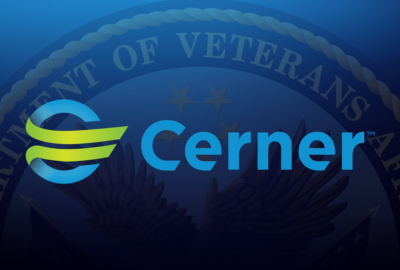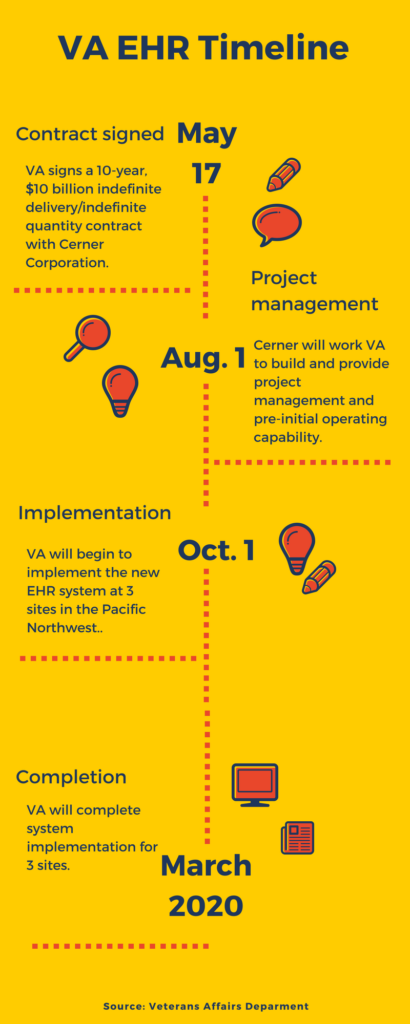

The Veterans Affairs Department says it will begin deployment of a new electronic health record at three sites in the Pacific Northwest in October, and the system...
Best listening experience is on Chrome, Firefox or Safari. Subscribe to Federal Drive’s daily audio interviews on Apple Podcasts or PodcastOne.
The Veterans Affairs Department has a slightly better idea now of how much exactly it will cost to retire more than 100 instances of its current Veterans Information Systems and Technology Architecture (VistA) in favor of a new electronic health record that’s interoperable with the Pentagon.
VA told lawmakers Tuesday that it’s estimated another $5.8 billion for project management costs, in addition to the 10-year, $10 billion contract it signed with Cerner Corporation last month.
Total costs, however, may be higher than VA’s $16 billion implementation estimate, said Dave Powner, director of IT management issues for the Government Accountability Office. VA’s estimate doesn’t account for additional government personnel costs, as VA adds more staff to project over time.
And it’s still unclear exactly how much it will cost to operate and maintain the new Cerner system once it’s deployed at the end of the 10-year timeline. VA currently spends roughly $1 billion to operate and maintain VistA.
Cerner Corporation, however, said it believes operation costs for the new health record will ultimately be less than what VA spends now on the existing VistA system.
“Several of those items that reflect some savings will be around the fact that today, [there are] over 100 different instances,” Cerner President Zane Burke told the House Veterans Affairs Committee Tuesday at a hearing on VA’s EHR modernization project. “You have a number of different training people [and] upgrades, [and] the updates are significantly more expensive in those models. We do anticipate taxpayer savings over time.”
For GAO, it’s still unclear what’s covered in the $10 billion contract price and VA’s $5.8 billion project management estimate. But if the federal government’s efforts to close and consolidate agency data centers are any indication, VA should realize some savings in the long run.
“I sure hope that it’s a hell of a lot less than the $1 billion that we currently spend,” Powner said. “We have standardization, we won’t have an old language, and we can save a lot of money in the hosting arena.”
VA said the indefinite delivery/indefinite quantity contract with Cerner will allow for “maximum flexibility” as the department begins a massive task. The agency so far has awarded Cerner three firm, fixed-price task orders on the contract. 
Cerner will build and provide project management, planning and pre-initial operating capabilities under the first task order. It will conduct facility assessments at three sites in the Pacific Northwest under the second task order and provide an EHR hosting solution under the third, acting VA Secretary Peter O’Rourke said in his written testimony.
VA will begin deployment at those three sites in October, with the goal of fully implementing the system by March 2020.
To date, VA has designated 260 full-time employees to the department’s new Electronic Health Record Modernization Program Office. VA will add more staff over time as the agency implements the new system to more sites, said John Windom, program executive officer for VA’s EHR modernization office.
The department also stood up five governance boards to manage project risks, Windom added.
Tuesday’s hearing before the House Veterans Affairs Committee was the first of what will likely be many oversight hearings on this topic from this group in Congress.
The House committee will form a specific technology modernization subcommittee to oversee the EHR. A small group of five members or so will sit on the subcommittee and will devote their attention solely to the project, House VA Committee Chairman Phil Roe (R-Tenn.) said.
For the most part, the VA and DoD witnesses, which included acting VA Secretary O’Rourke and Defense Health Agency Director Vice Adm. Raquel Bono, said all the right things. Both departments said they’re working together and meeting weekly. The Pentagon is sharing the lessons it learned so far in implementing a new electronic record at four military treatment facilities in the Pacific Northwest.
“We have a fair amount of experience now with the change management and the workflow adoption, and that’s something that we want to be able to make sure [to] share with the VA,” Bono said. “Because this is a single instance of a medical record, that is it’s the same medical record, we recognize that being able to assist in the adoption of workflows that are common across DoD and VA will enable a faster deployment for us both.”
Members across the committee, however, said they were concerned by the gaping holes within VA’s highest leadership ranks and the impact those vacancies would have on a massive project.
VA currently lacks a permanent secretary and deputy secretary. The Senate VA Committee is scheduled to hold the nomination hearing for Robert Wilkie, who briefly served as the department’s acting secretary immediately following Secretary David Shulkin’s removal in March. Wilkie currently serves as the Pentagon’s undersecretary for personnel and readiness.
In addition, VA still doesn’t have a permanent undersecretary for health. Three commissions have formed over the past year to choose candidates for this position to submit to the White House, but no name has surfaced.
The department also lacks a permanent chief information officer. Camilo Sandoval currently serves as VA’s acting CIO, and Democrats have publicly questioned his ethics and qualifications.
“I remind you, we’re undertaking a $10-billion-to-$15 billion dollar initiative, and we don’t have these critical positions filled,” Rep. Mark Takano (D-Calif.) said.
“I agree,” O’Rourke said.
Previous failed VA projects and high-profile scandals have erupted because of a lack of permanent leadership and high turnover, members said.
“The VA in particular, whether it’s Denver, Phoenix or projects that have worked wonderfully and are moving forward … leadership will make or break this project,” Ranking Member Tim Walz (D-Minn.) said. “So will oversight.”
“There are going to need to be eyes on this all the way,” he added. “Every one of us up here, we own this now. We own this. We can complain about Denver, we can try to get fixes. We get to start fresh.”
But for Walz, VA hasn’t gotten off to the best start when it comes to transparency. Walz said he received an electronic notification from the department Tuesday morning, which included a status update on VA’s EHR Modernization Office. The memo was the first piece of communication Walz said he’s received from VA on this topic in months. The notification mentioned an attachment, but the message didn’t include it, Walz said.
Copyright © 2025 Federal News Network. All rights reserved. This website is not intended for users located within the European Economic Area.
Nicole Ogrysko is a reporter for Federal News Network focusing on the federal workforce and federal pay and benefits.
Follow @nogryskoWFED




